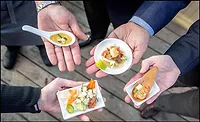2021 Foodservice Distributor of the Year: US Foods
How US Foods delivered crucial business solutions to its customers during foodservice’s most challenging year.

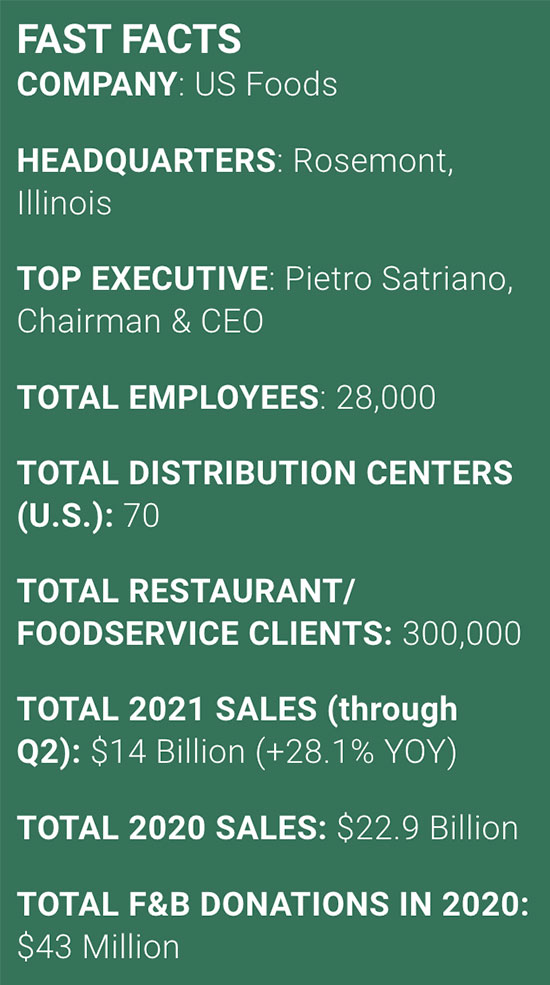
(Editor's note: this story originally appeared in the September issue of Food Engineering's sister publication, Refrigerated & Frozen Foods.)
At this time last year, we at Refrigerated & Frozen Foods decided to put our annual Foodservice Distributor of the Year Award on hold. The COVID-19 pandemic precipitated unprecedented shutdowns in foodservice—restaurants, hotels, schools, caterers, stadiums, and other volume venues—leaving behind thousands of shuttered businesses. To put it lightly, there was very little to celebrate in foodservice last year.
However, during that time, distributor US Foods pulled the ultimate pivot—transforming on the fly into a multi-faceted business strategy source for customers confused about how to stay open with no on-premise dining, and offering vital support to operators when they may otherwise have folded in 2020.
US Foods delivered an array of practical programs via webinars and one-on-one client consultations focused on alternative revenue streams like ghost kitchens; strategies to execute delivery and takeout menus; navigating the $2.2 trillion CARES Act to claim funds; operational blueprints for reopening with coronavirus restrictions; supplies and products tailored to pandemic precautions; and much more.
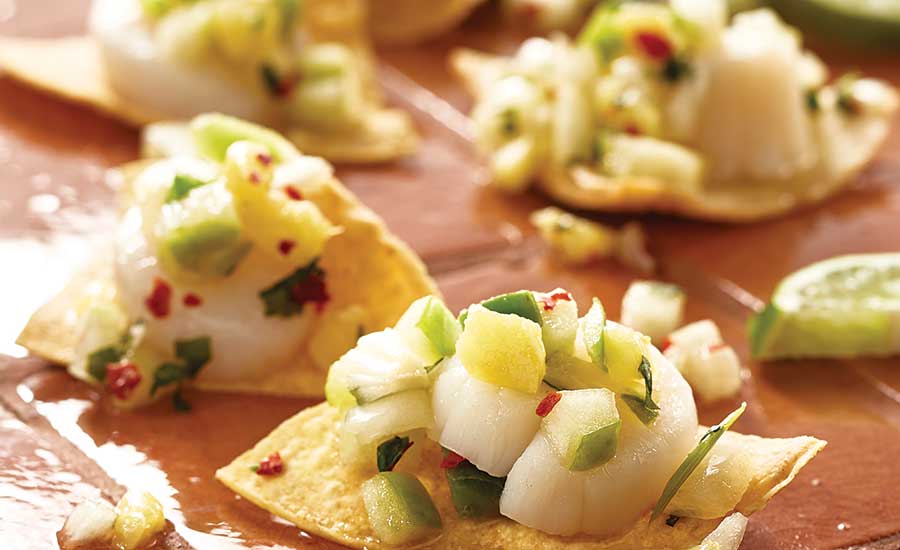 Labor-saving apple/pineapple pico de gallo developed by US Foods as a versatile menu solution for its clients. All photos courtesy of US Foods.
Labor-saving apple/pineapple pico de gallo developed by US Foods as a versatile menu solution for its clients. All photos courtesy of US Foods.
“Being able to rise above the challenges and continue to innovate with programming that helped independent operators survive and sometimes thrive during the pandemic was very rewarding,” says Jim Osborne, SVP, customer strategy & innovation at US Foods. “Our ‘We Help You Make It’ approach has always been about helping operators succeed, and never has that been more important than it is today. I’ve heard many customers say our tagline is more than just a tagline during these times; it’s a lifeline.”
Today, the industry is cautiously emerging from the pandemic—the Delta variant is still an X factor right now—and restrictions on in-person dining have mostly been lifted, and elevated along with it, is foodservice distribution.
US Foods’ recovery—indicative of foodservice’s rebound overall—is reflected through its recent quarterly and annual fiscal reports. In 2020 during the pandemic, the company’s sales decreased 11.8% to $22.9 billion compared to 2019. So far through Q2 of 2021, sales have increased 28.1% to $14 billion, on track for $28 billion in sales, which would easily eclipse 2019’s pre-pandemic $25.9 billion.
“In 2020, our case volume for restaurants fell close to 60% before starting to rebound in May and June. Since then, our case volume and deliveries have quickly recovered as restaurants and consumers adapted to off-premise dining,” Osborne says. “By the end of June 2021, total legacy case volume for US Foods was back to within 3% to 4% of 2019 levels. This gives us confidence that the industry and our deliveries to customers will fully recover and exceed 2019 levels in the future.”
That recovery has its foundation in the tough work and pragmatic decisions made by US Foods in 2020 that kept clients on course to stay solvent. Here are some of the innovations, programs and initiatives executed by US Foods over the past year that helped it earn our 2021 Foodservice Distributor of the Year Award.
 US Foods addressed the shift to carry-out and delivery menus during the past year by creating these custom takeaway containers and pouches for customers.
US Foods addressed the shift to carry-out and delivery menus during the past year by creating these custom takeaway containers and pouches for customers.
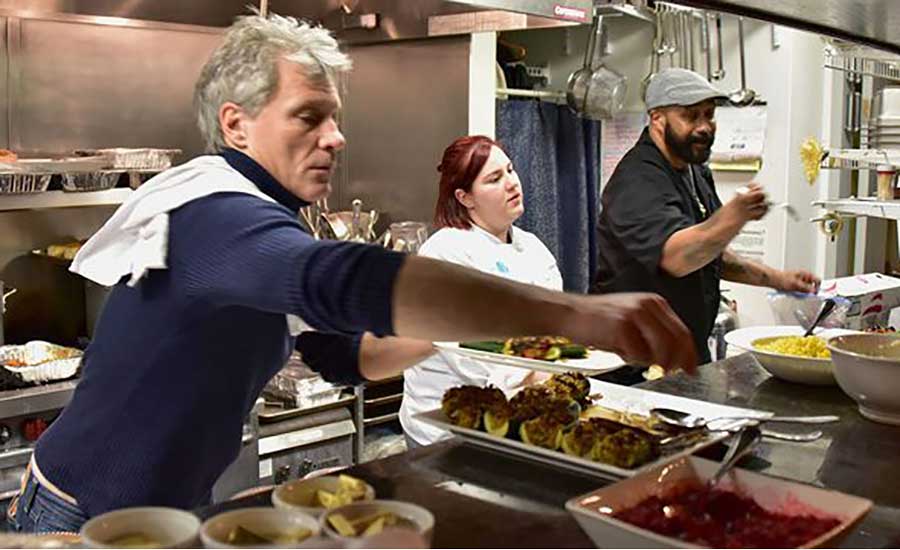 US Foods contributed to several high-profile meal packing events during the pandemic, including this one with musician Jon Bon Jovi's JBJ Soul Foundation supporting food pantries on Long Island.
US Foods contributed to several high-profile meal packing events during the pandemic, including this one with musician Jon Bon Jovi's JBJ Soul Foundation supporting food pantries on Long Island.
Support Strategies
While retail sales soared for refrigerated and frozen foods during the pandemic, the cold chain was also significantly impacted by foodservice shutdowns. It’s estimated that large processors making cold foods produce approximately one-third of their inventory for foodservice use. US Foods says about 50% of its own F&B inventory is perishable, so when foodservice sales stop, changes are necessary to compensate.
The word “pivot” was used often during the pandemic to describe adjustments made by businesses to counter and cope with the daily disruptions COVID-19 had on their operations. It’s not a stretch to say foodservice distribution had to pivot the hardest along the cold chain, since their traditional business model—high-volume deliveries of F&B to clients for primarily on-premise dining—evaporated once restrictions were put in place.
“We played an integral role in helping independent restaurant owners across the country innovate and adapt their businesses in every way they needed as the pandemic changed the landscape. All our programs and innovations were not just available to customers, but to any operator who needed support,” says Osborne.
Those initiatives included “deploying our national team of restaurant operations consultants, available 24/7, to advise, counsel and support restaurateurs with one-on-one consultations and webinars to support them as COVID-19 restrictions took hold,” Osborne explains. “We created in-depth operating playbooks on how to apply CDC guidance to safely reopen; we delivered reopening kits containing vital information and supplies to operators, offered free of charge; we developed the first-to-market Ghost Kitchen Playbook, a how-to guide for setting up a new revenue stream with a ghost kitchen operation; and we were also first-to-market to offer free webinars and consultations to help navigate the CARES Act, a $2.2 trillion economic stimulus bill to help restaurants fund ongoing operations.”
The CARES Act in particular was difficult for many operators to understand, according to Osborne, and they were apprehensive about applying because they didn’t know where to begin. Osborne says through direct feedback from their customers about US Foods’ assistance with the CARES Act, they were able to uncover billions in funding for clients.
One example of many is Menches Brothers Restaurant in Uniontown, Ohio, which received more than $100,000 in tax credits with US Foods’ help. “Our CARES Act support was hands-down the star of the show in 2020,” says Osborne. “Having a team of dedicated consultants focused on helping struggling operators uncover billions of dollars in relief that they didn’t know how to receive was one of the most powerful examples of how we helped operators ‘Make It’ that I could ever imagine.”
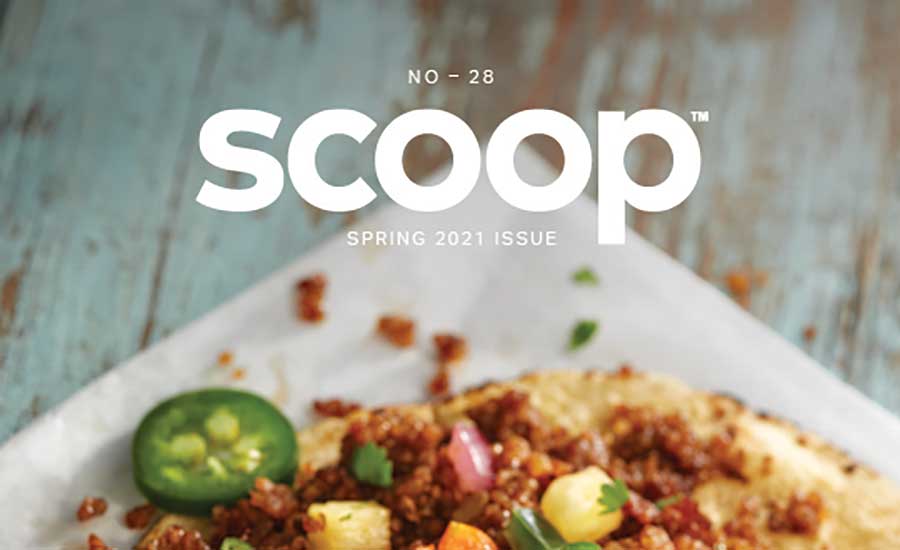 US Foods publishes its seasonal Scoop catalog for customers, addressing menu trends with relevant products produced by the company. During the pandemic, Scoop's focus shifted toward time-saving foods and tamper-evident packaging, addressing the immediate need for takeaway supplies.
US Foods publishes its seasonal Scoop catalog for customers, addressing menu trends with relevant products produced by the company. During the pandemic, Scoop's focus shifted toward time-saving foods and tamper-evident packaging, addressing the immediate need for takeaway supplies.
Proactive Products
US Foods has its own in-house catalog of new products and supplies created exclusively for customers, called Scoop. In years past, Scoop was about anticipating emerging menu trends, then tasking the company’s R&D chefs to create F&B that addressed those trends and deliver to clients to help them generate more revenue. In 2020 though, the shift toward carry-out, delivery, and curbside pick-up, along with a labor crunch, necessitated a fresh approach to Scoop’s offerings.
“We continue to design and launch labor-saving products in Scoop, but they are arguably more relevant than ever,” says Stacey Kinkaid, VP of product development and innovation at US Foods. These include time-saving products launched within the past year like the company’s four-ounce bags of pre-chopped fresh cilantro, which saves an estimated 60 minutes of labor. Other new products include pre-made Alabama white barbecue sauce, which saves about 30 minutes of work; a Roman-style arancini, saving three-hours compared to scratch preparation; ready-to-serve pico de gallo; pre-sliced and marinated carne asada steak strips; and organic kombucha in single-serve cans that can be easily added to delivery and take-out menus.
“We continue to develop products specific for off-premise growth as we don’t expect this to slow in the coming months. This includes individually wrapped grab-and-go options, unique packaging options and our portfolio of tamper evident bags, pouches and labels,” Kinkaid says. “Restaurant operators struggle to balance the resurgence of on-site diners and existing take-out and delivery operations ramped up during the pandemic. Our latest summer Scoop helps address these challenges and can help operators save approximately 85% to 95% in back-of-house preparation time compared to making from scratch, helpful for restaurants operating with fewer and less experienced kitchen staff.”
Sustainability is another area where US Foods is devoting its R&D resources, both for menus and packaging. New products include taco-flavored quinoa crumbles and a vegan sweet potato flatbread to help address demand for flexitarian options, and for ongoing carry-out and delivery operations, a 32-ounce pulp folding container to transport orders, made with bagasse fiber, which is leftover after sugarcane is processed.
“Diners are demanding products with sustainable attributes,” notes Kinkaid, “and research shows that these consumer behaviors have only intensified since the start of the pandemic.”
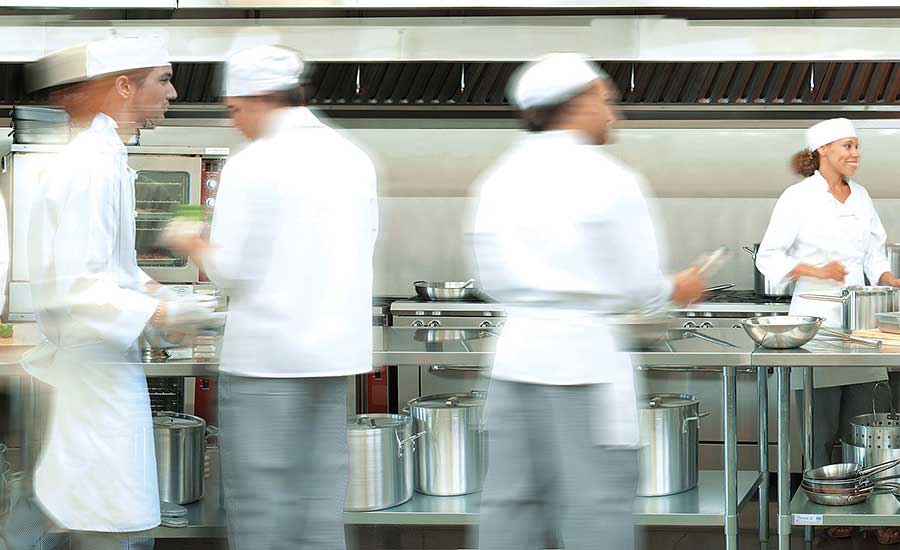 US Foods' R&D chefs have been busy creating labor-saving menu items for customers to help ease the burden of an ongoing staffing crisis in foodservice.
US Foods' R&D chefs have been busy creating labor-saving menu items for customers to help ease the burden of an ongoing staffing crisis in foodservice.
Dedicated Distribution
US Foods currently operates 70 distribution centers across the United States, amounting to more than 18 million square feet. The company just opened a new facility in New Orleans, and has another in Sacramento opening soon.
“We’re always looking to see how we can grow and utilize our network depending on customer needs. This could come either through brownfield expansions or greenfield facilities,” says Osborne. “We also make strategic investments where needed on both our fleet and our distribution centers to ensure we have the right amount of storage for our customers. In addition, we strive to use our existing assets most efficiently. For example, we continuously improve our routing algorithms to make best use of our refrigerated trucks.”
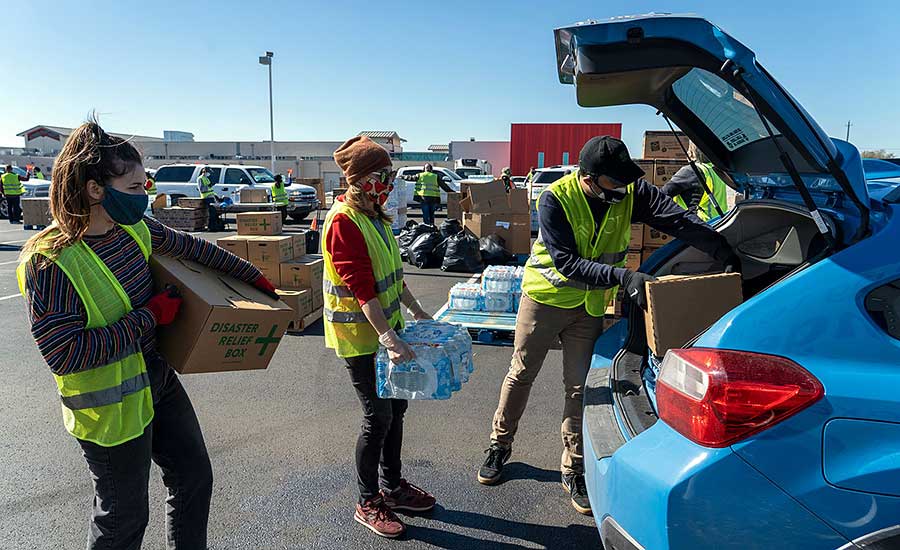 US Foods donated $43 million in F&B and other supplies to help feed people left economically vulnerable by the pandemic.
US Foods donated $43 million in F&B and other supplies to help feed people left economically vulnerable by the pandemic.
Community Outreach
While foodservice was in flux last year, US Foods dedicated much of its inventory and resources to helping those out of work and in need of basics like food. The company donated $43 million in F&B and other supplies to help feed people left economically vulnerable by the pandemic.
“Our teams worked with Feeding America food banks, local partners, customers and community leaders to donate critical resources to those who needed it most,” Osborne says. “These donations provided millions of meals to feed families struggling with stay at-home orders, healthcare workers, and students facing school closures. For example, the US Foods team in Hurricane, West Virginia, donated 56,000 meals to local students from 18 schools throughout the county. In Phoenix, Arizona, our team donated more than $100,000 of protein and produce to St. Mary’s Food Bank within the first weeks of the pandemic to provide immediate relief and meet increasing demand.”
US Foods also lent support to displaced foodservice workers impacted by the pandemic. The company offered logistics help and resources for high-profile meal packing events, collaborating with Chicago chef Rick Bayless to feed furloughed restaurant employees; musician Jon Bon Jovi’s JBJ Soul Foundation supporting food pantries in Long Island; and Chef José Andrés, aiding his Chef Relief Team to deliver food and supplies across the country.
From today’s perspective, the initiatives and strategies undertaken by US Foods in 2020 not only helped their clients survive during the pandemic, but positioned them to thrive in what is now a very different foodservice environment than before coronavirus.
“Our restaurant customers have proved to be very resilient and have been the quickest to recover, while our hospitality customers, which includes hotels, stadiums and caterers, have been a little slower to recover, but case volume with those clients has started to improve,” says Osborne. “Consumer adoption of digital ordering and off-premise dining is well ahead of pre-pandemic levels, and when you combine this with the return of in-person dining, the future outlook for our industry is extremely bright.”
Looking for a reprint of this article?
From high-res PDFs to custom plaques, order your copy today!





